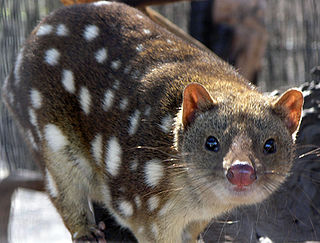
The Dasyuridae are a family of marsupials native to Australia and New Guinea, including 75 living species divided into 21 genera. Many are small and mouse-like or shrew-like, giving some of them the name marsupial mice or marsupial shrews, but the group also includes the cat-sized quolls, as well as the Tasmanian devil. They are found in a wide range of habitats, including grassland, forests, and mountains, and some species are arboreal or semiaquatic.

Latastia is a genus of lizards of the family Lacertidae. Species of this genus are distributed in Africa but one subspecies lives in Yemen. Collectively, they are known as long-tailed lizards.
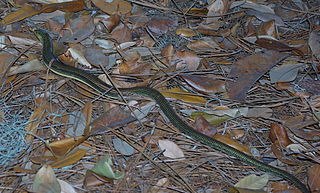
Ophisaurus is a genus of reptiles that resemble snakes, but are actually lizards. Although most species have no legs, their head shapes, movable eyelids, and external ear openings identify them as lizards. A few species have very small, stub-like legs near their rear vents. These are vestigial organs, meaning they have evolved and are no longer in use. They reach lengths of up to 1.2 metres (4 ft), but about two-thirds of this is the tail. Glass lizards feed on insects, spiders, other small reptiles, and young rodents. Their diets are limited by their inability to unhinge their jaws. Some glass lizards give birth to live young but most lay eggs.
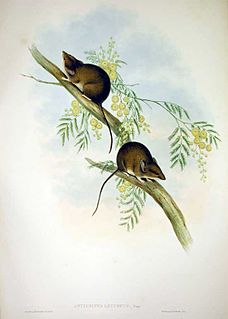
Dunnart is a common name for species of the genus Sminthopsis. narrow-footed marsupials the size of a european mouse. They have a largely insectivorous diet.
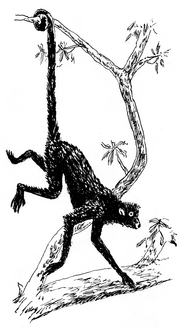
A prehensile tail is the tail of an animal that has adapted to be able to grasp or hold objects. Fully prehensile tails can be used to hold and manipulate objects, and in particular to aid arboreal creatures in finding and eating food in the trees. If the tail cannot be used for this it is considered only partially prehensile - such tails are often used to anchor an animal's body to dangle from a branch, or as an aid for climbing. The term prehensile means "able to grasp".

Lepidosauromorpha is a group of reptiles comprising all diapsids closer to lizards than to archosaurs. The only living sub-group is the Lepidosauria: extant lizards, snakes, amphisbaenians and tuataras.

Varanus salvadorii is a species of monitor lizard endemic to New Guinea. Its common names include crocodile monitor, Papua(n) monitor, Salvadori's monitor and artellia. It is the largest monitor lizard known from New Guinea, and is one of the longest lizards in the world, verified at up to 244 cm (8 ft). The tail of the species is exceptionally long, so that some specimens have been claimed to exceed the length of the world's largest lizard, the Komodo dragon; however, Varanus salvadorii is far less massive.
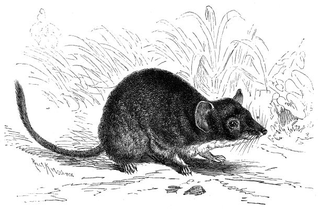
The Phascogalini are a tribe in the family Dasyuridae, comprising seven genera of small marsupials native to Australia and New Guinea.

The subfamily Sminthopsinae includes several genera of small, carnivorous marsupials native to Australia: kultarrs, ningauis, dunnarts, and planigales.

The long-tailed dunnart(Sminthopsis longicaudata) is an Australian dunnart that, like the little long-tailed dunnart, has a tail longer than its body. It is also one of the larger dunnarts at a length from snout to tail of 260–306 mm of which head to anus is 80–96 mm and tail 180–210 mm long. Hind foot size is 18 mm, ear length of 21 mm and with a weight of 15-20 g.

Legless lizard may refer to any of several groups of lizards that have independently lost limbs or reduced them to the point of being of no use in locomotion. It is the common name for the family Pygopodidae, but often refers to other groups, such as limbless anguids, depending on the region of the world. These lizards are often distinguishable from snakes on the basis of one or more of the following characteristics: possessing eyelids, possessing external ear openings, lack of broad belly scales, notched rather than forked tongue, having two, more-or-less equal, lungs and/or having a very long tail.

The spiny-tailed monitor, also known as the ridge-tailed monitor or Ackies dwarf monitor, is an Australian species of lizard belonging to the genus of monitor lizards (Varanus).

Olyra is a genus of catfishes of the family Bagridae. This genus occurs throughout South Asia and western Indochina, from India to western Thailand.
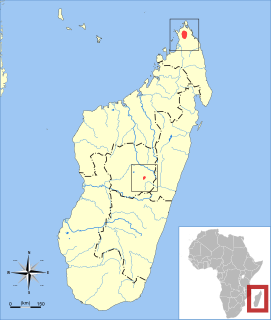
The lesser long-tailed shrew tenrec is a species of mammal in the family Tenrecidae. It is active at all hours of the day and night, but each individual maintains its own pattern of rest and activity.
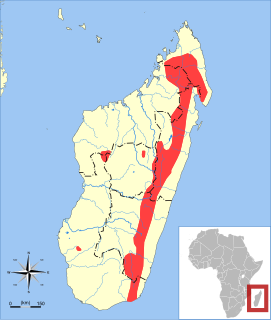
Major's long-tailed tenrec is a species of mammal in the family Tenrecidae. It is endemic to Madagascar. Its natural habitat is the eastern humid forest of the island, as well as some western forests, where it has been seen at elevations from 785 to 2000 m. Its habits are not well known, but it is thought to be semiarboreal. The species was formerly viewed as synonymous with M. longicaudata. It was named in honor of zoologist C. I. Forsyth Major.

Palaeohatteria is an extinct genus of basal sphenacodonts known from the Early Permian period of Saxony, Germany. It contains a single species, Palaeohatteria longicaudata.
Oryzorictinae is a subfamily of tenrecs endemic to the island of Madagascar. It is the largest of three tenrec subfamilies. Oryzorictinae is thought to have split from the lineage of its closest relative, Geogale, about 30 million years (Ma) ago. The deepest phylogenetic split within the subfamily, that between Oryzorictes and a clade composed of Microgale plus Nesogale, is thought to have occurred about 28 Ma ago. In turn, Microgale and Nesogale are thought to have diverged about 19 Ma ago.
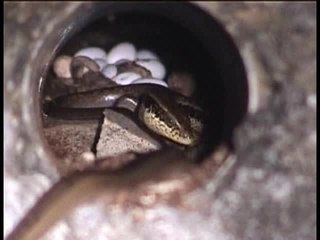
Longtail Mabuya or Long-tailed Sun Skink is a species of skink. It is found in China, Taiwan, Malaysia, Indonesia, Thailand, Laos, Vietnam and possibly in Cambodia. Some populations have been found to exhibit paternal care in response to predation by egg-eating snakes.
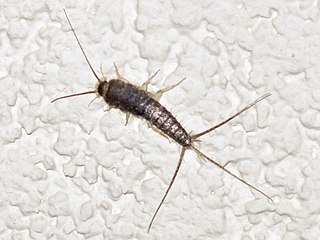
Ctenolepisma longicaudata, known generally as the gray silverfish or long-tailed silverfish, is a species of silverfish in the family Lepismatidae. It is found in the Caribbean, North America and Europe.



















